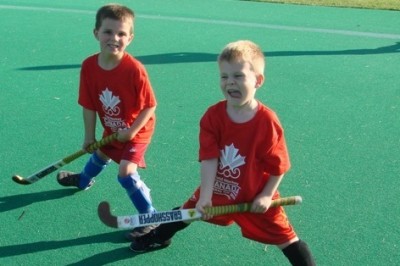
Boys and Girls Age 6-10
In the FunStix stage children need to participate in a variety of well-structured activities that develop basic field hockey skills and promote interest in physical activity. Physical literacy continues to be developed through activities involving the athlete in as many sporting activities as possible throughout the week. It is important that all children master fundamental movement skills before sport specific skills are introduced.
Competition should involve no formal game play. Modified games, such as the FunStix mini game, should be introduced. All activities are fun-based. The focus should be on creating self-esteem within participants by reinforcing individual effort and not keeping score. Activities should be incorporated into everyday life including unstructured play with friends and through quality instruction in a structured environment in physical education classes, hockey clubs, and junior programs designed by provincial field hockey associations.
The first window of trainability for speed, particularly hand and foot speed, as well as the trainability windows for flexibility and fundamental skills occurs at this stage. This refers to the point in the development of a specific area when training has an optimal effect. However it should be noted all systems are always trainable!
Physical
Fun fitness activities are used to begin developing aerobic fitness, muscular strength/endurance with own body weight, flexibility, and stability. This stage features the first “window” of speed training (accelerated adaptation to training), for girls 6-8 girls and boys 7-9.
Developing physical literacy is fundamental with emphasis on developing basic movement skills: Running, Jumping, Striking, Catching, and General Motor Abilities (ABCs: Agility, Balance, Coordination, Speed).
Technical
Athletes are introduced to the Five FunStix Principles of Hockey and their related stage-appropriate skills. These Principles are:
- Ball Movement and Control
- Passing & Receiving
- Scoring
- Winning the ball from Opponents
- Mini and Modified Games
Hockey Skill Introduction: Open stick dribbling, Indian dribble, push pass, backhand pass, closed receiving, and double-handed block tackle.
All skills should be trained in both stationary and dynamic positions. As a unique aspect of field hockey, particular emphasis should be on the use of the reverse side of the stick and turning the stick over. This is a significant motor skill requiring introduction at this early age.
Tactical
The push pass, and its associated decision-making component, is the most important basic tactical skill in this stage. The most essential decisions around passing are: Timing, Direction, and Speed.
In the modified games the push pass will keep the games flowing and is a key building block to the introduction of “set plays” as the athletes and coaches progress on to full games. Pushing is also the technique used for scoring in this stage.
Focus on fun games that promote teamwork and exploration of spatial awareness. Holding festivals at the end of season or end of program emphasizes fun and participation.
Mental
Coaches focus on creating self-esteem within participants through reinforcement of individual efforts (self and others) versus outcomes. For example, complimenting the technique used in a pass rather than if it reached its intended target. Emphasize and model sportsmanship and open communication with coach and peers.
Mental capabilities: Experience enjoyment of competition, positive reinforcement of strengths, focus on effort-based goals versus outcome (winning), basic self awareness of thinking and feeling states, basic imagery with little structure (promote creativity), and sportsmanship and ethical play.
Some implications for the coach: Serve as positive role model, teach athletes that mistakes or poor performance are not “bad”, focus on processes (efforts) not on the outcome (winning), and start to develop basic self awareness.
Health
Participants have at least 90 minutes of physical activity every day with 60 minutes of moderate activity and 30 minutes of vigorous. Activities can be in bouts of 5-10 minutes.
Nutrition: Ensure adequate nutrition, but avoid over-eating. Optimize hydration.
Participants sleep as much as desired.
Strength and Flexibility: Promote good movement pattern habits and proper technique. As sport specific training increases, choose alternate activities that emphasize different movements to decrease risk of injury from muscle imbalance. No maximal or near-maximal strength activities to preserve growth plates.
Equipment: Use equipment (ie. Sticks, balls) to match physical size and skill of child
Injury Prevention: Coaches are to teach body awareness and teach proper ‘change of direction’ technique.

